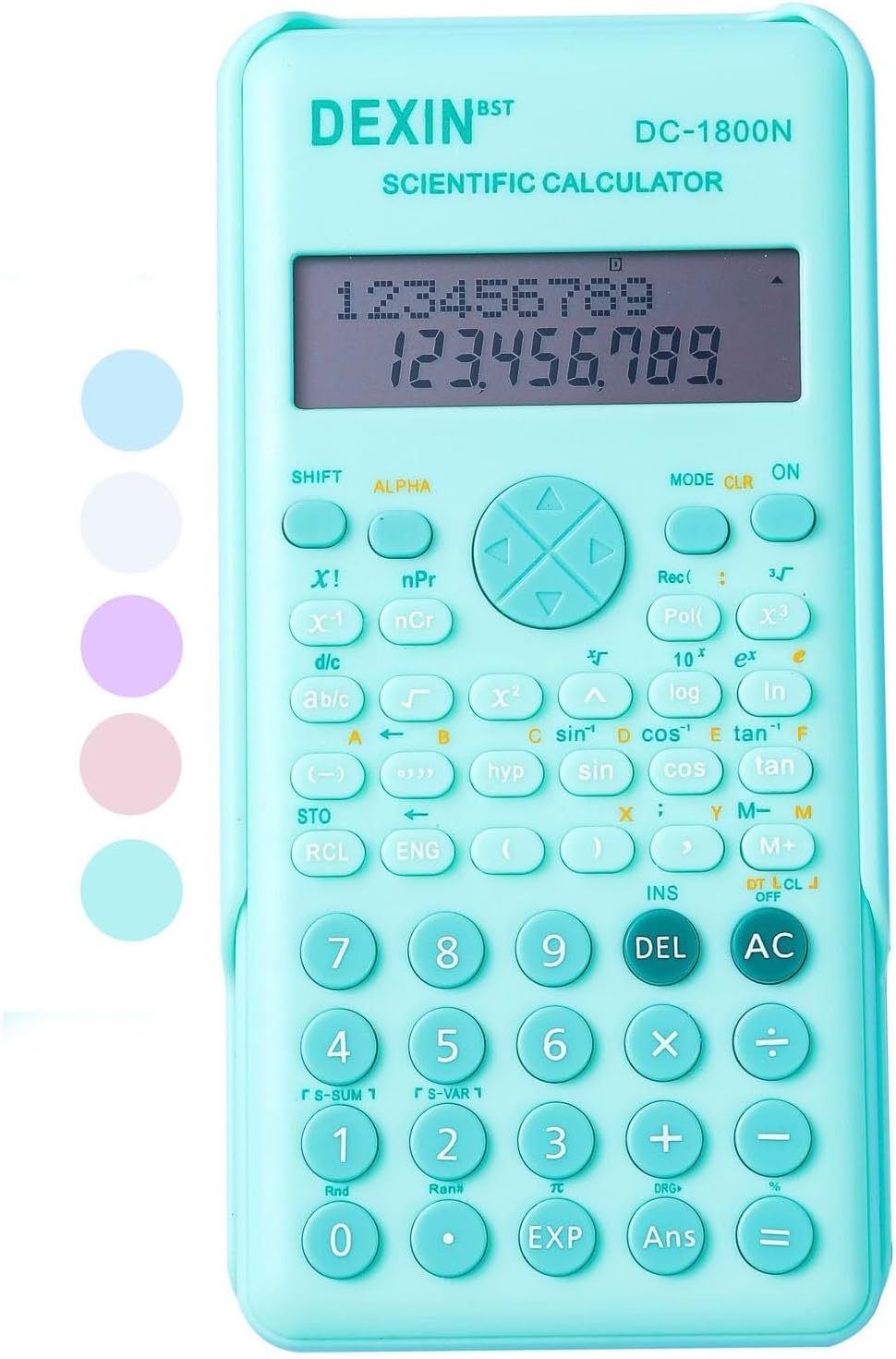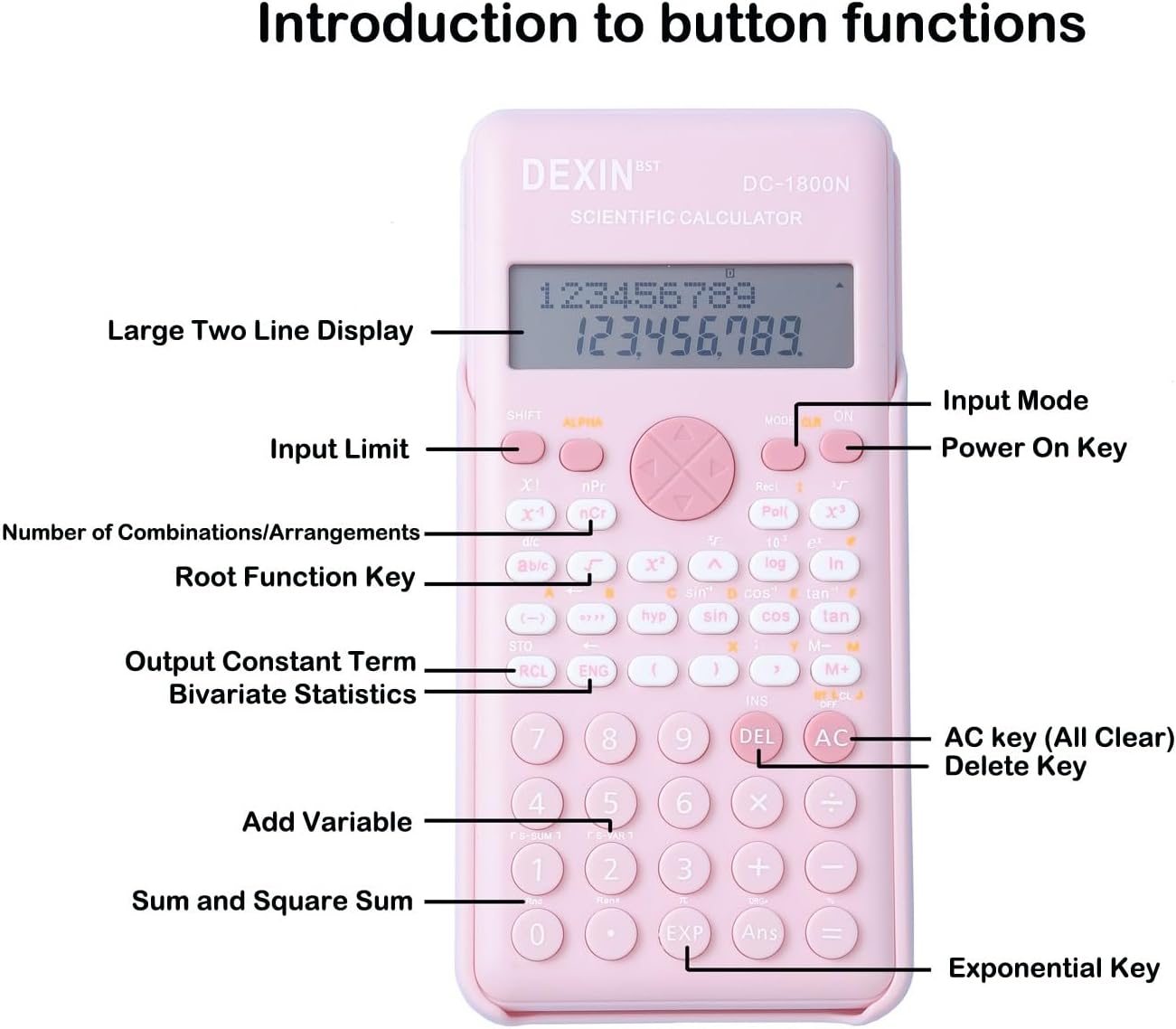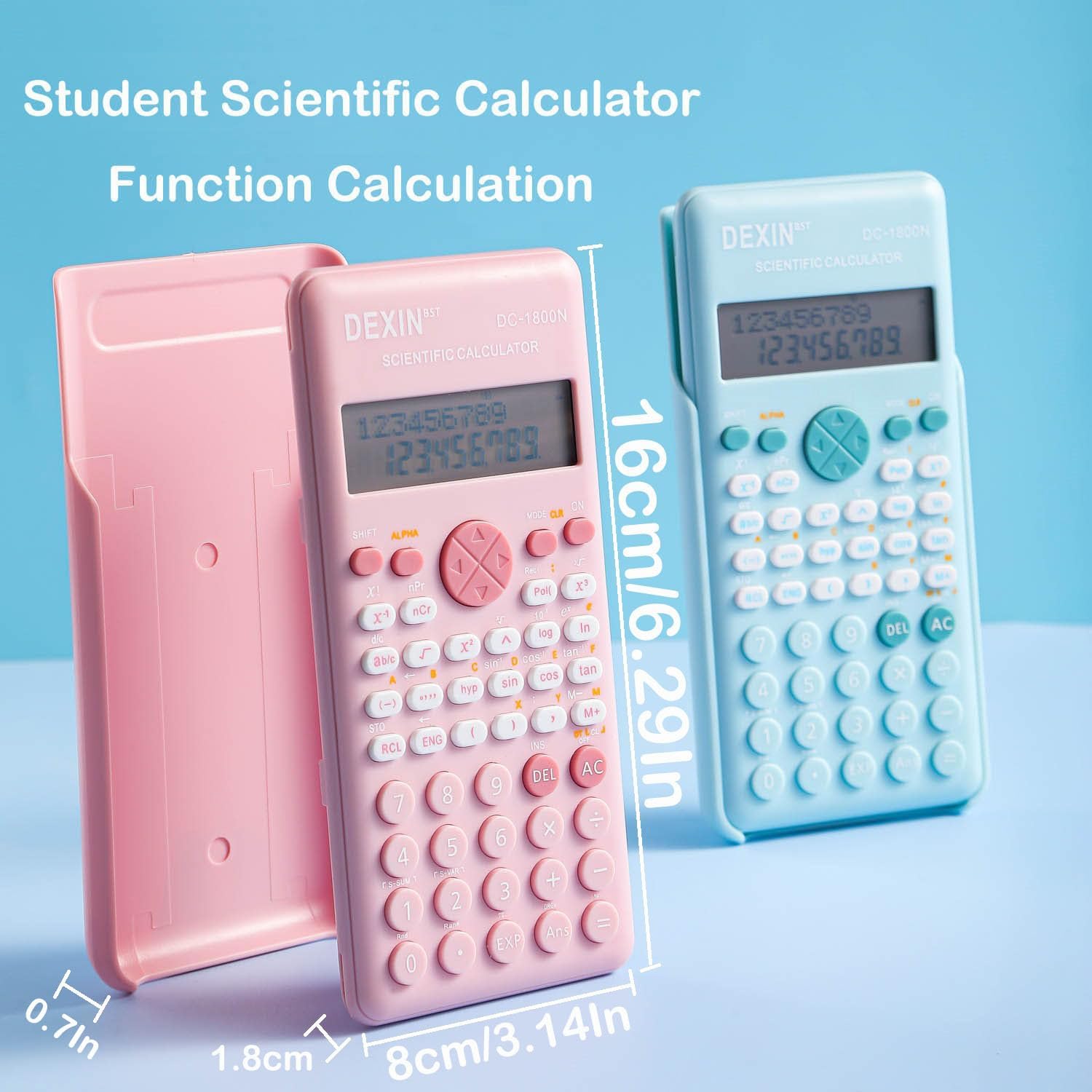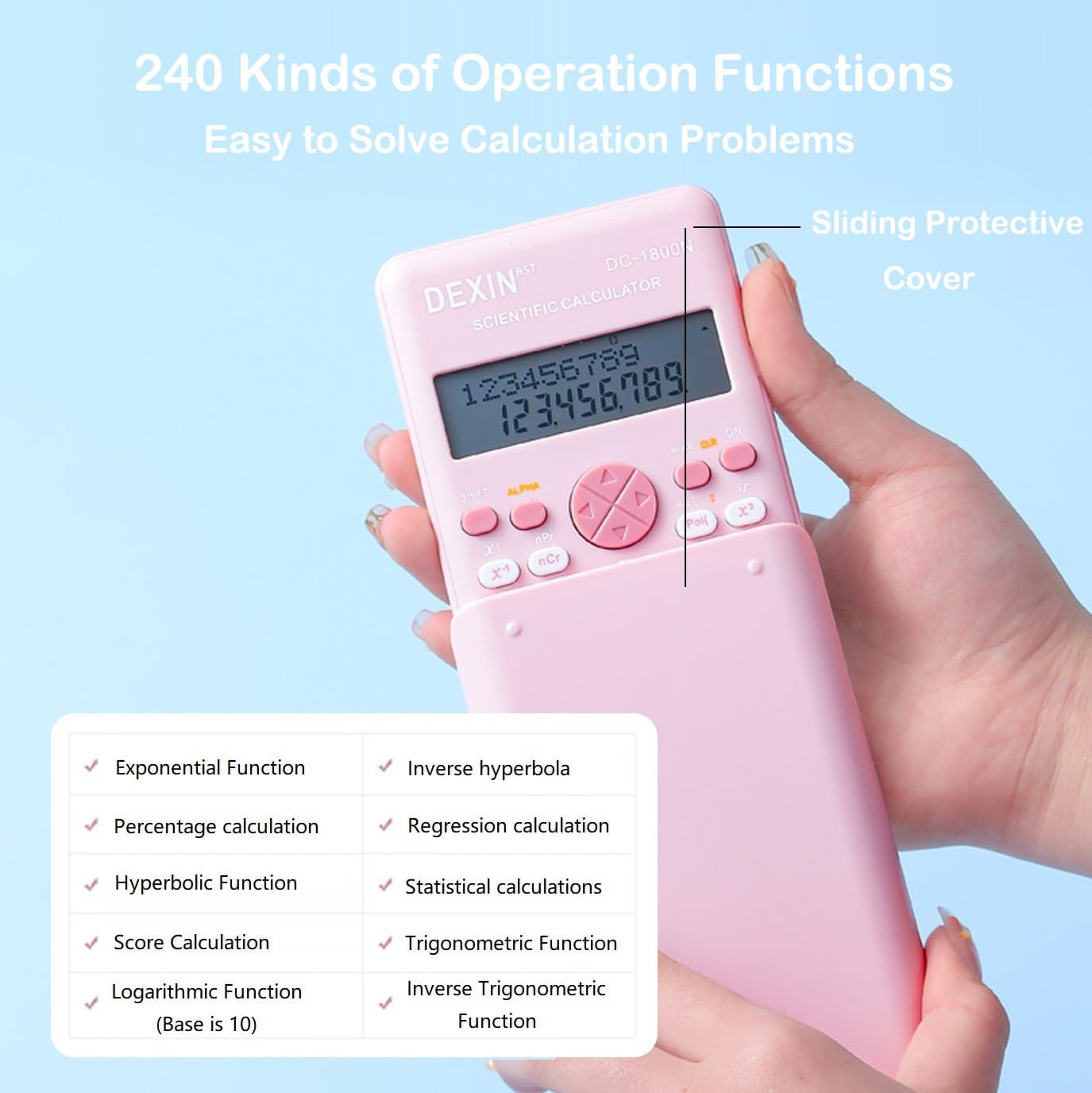
Scientific Calculators for Students, 240 Review calculator – Oemiu
Scientific Calculators for Students: A Comprehensive Review of the 240 Model
For students navigating the intricate world of mathematics, physics, chemistry, and engineering, a reliable scientific calculator is an indispensable tool. It’s more than just a device for crunching numbers; it’s a partner that aids in problem-solving, exploration, and a deeper understanding of complex concepts. Selecting the right calculator can significantly impact academic performance, making it a crucial decision. This article provides a comprehensive review of a popular and versatile option: the 240 model scientific calculator, exploring its features, functionalities, and suitability for different academic levels.
The Essential Role of Scientific Calculators in Education
Scientific calculators have moved far beyond simple arithmetic. They are now sophisticated tools equipped with a range of functions, from trigonometric calculations and statistical analysis to complex number manipulations and unit conversions. For students, this means being able to tackle problems that would be nearly impossible to solve by hand, freeing them to focus on the underlying principles rather than getting bogged down in tedious calculations. A good scientific calculator can empower students to explore mathematical concepts in a more hands-on way, allowing them to visualize equations, experiment with different parameters, and gain a more intuitive understanding of the subject matter. In fields like physics and engineering, where complex equations and data analysis are commonplace, a scientific calculator is not just helpful – it’s essential. Consider a physics student studying projectile motion; a scientific calculator allows them to quickly calculate the trajectory of an object under various conditions, exploring the impact of factors like initial velocity and launch angle. This level of interactivity fosters a deeper engagement with the material and enhances learning outcomes. Furthermore, the ability to perform statistical analysis on-the-fly makes these calculators invaluable for science students collecting and interpreting data. Whether it’s calculating standard deviations, performing regression analysis, or generating probability distributions, a scientific calculator streamlines the process and allows students to focus on the interpretation of the results rather than the computational details. Students should consider getting the best student calculator they can afford.
Understanding Core Functionalities
The core functionality of a scientific calculator revolves around its ability to perform a wide range of mathematical operations. These operations include:
- **Basic arithmetic:** Addition, subtraction, multiplication, division, exponents, and roots.
- **Trigonometric functions:** Sine, cosine, tangent, and their inverses, along with hyperbolic functions.
- **Logarithmic functions:** Natural logarithms (ln) and base-10 logarithms (log).
- **Statistical functions:** Mean, standard deviation, variance, regression analysis.
- **Memory functions:** Storing and recalling numbers for later use.
- **Angle modes:** Degrees, radians, and gradians.
- **Number systems:** Decimal, binary, octal, and hexadecimal conversions.
These features are not simply isolated functions; they are interconnected and designed to work together to solve complex problems. For instance, a student solving a problem in thermodynamics might need to use logarithmic functions to calculate entropy changes, statistical functions to analyze experimental data, and trigonometric functions to resolve vectors. The ability to seamlessly switch between these functions and utilize them in combination is what makes a scientific calculator such a powerful tool. Moreover, features such as equation solvers and numerical integration capabilities further enhance the calculator’s versatility, allowing students to tackle problems that would be difficult or impossible to solve analytically. Therefore, a thorough understanding of these core functionalities is essential for students to effectively utilize a scientific calculator and maximize its potential as a learning aid.
In-Depth Look at the 240 Model Scientific Calculator
The 240 model scientific calculator is a popular choice among students due to its balance of functionality, affordability, and ease of use. It is designed to meet the needs of a wide range of academic disciplines, from basic algebra and trigonometry to calculus and statistics. One of the key strengths of the 240 model is its intuitive interface. The buttons are well-spaced and clearly labeled, making it easy to input equations and navigate through the different functions. The display is typically a multi-line LCD screen, allowing users to view entire equations and previous calculations, which helps in identifying and correcting errors. In terms of functionality, the 240 model typically includes all the standard features expected in a scientific calculator, such as trigonometric functions, logarithmic functions, statistical functions, and memory functions. It often also includes more advanced features like equation solvers, numerical integration, and complex number calculations, making it suitable for more advanced courses. Another significant advantage of the 240 model is its durability. These calculators are typically built to withstand the rigors of student life, with sturdy casings and buttons that can handle frequent use. They also tend to have long battery life, ensuring that they will last through exams and extended study sessions. Furthermore, the 240 model is often programmable, allowing students to create custom functions and store frequently used formulas. This can be a significant time-saver in courses that require repetitive calculations. Overall, the 240 model scientific calculator offers a compelling combination of functionality, usability, and durability, making it a solid choice for students of all levels. It is particularly well-suited for students who need a reliable and versatile calculator that can handle a wide range of mathematical and scientific tasks without breaking the bank. It stands as a versatile and affordable option for many looking for a programmable scientific calculator.
Key Features and Specifications
Let’s delve into the specific features and specifications that make the 240 model scientific calculator a compelling choice for students. These specifications often vary slightly depending on the specific manufacturer and model variant, but the core functionalities remain consistent.
- **Display:** Typically a multi-line LCD screen, allowing for the display of multiple lines of input and output, making it easier to review and edit equations.
- **Input Logic:** Often utilizes algebraic logic, allowing users to input equations in the same way they would write them on paper.
- **Trigonometric Functions:** Includes sine, cosine, tangent, and their inverses, as well as hyperbolic functions.
- **Logarithmic Functions:** Includes natural logarithms (ln) and base-10 logarithms (log).
- **Statistical Functions:** Includes mean, standard deviation, variance, regression analysis, and probability distributions.
- **Memory Functions:** Typically includes multiple memory locations for storing and recalling numbers and intermediate results.
- **Angle Modes:** Supports degrees, radians, and gradians.
- **Number Systems:** Supports conversions between decimal, binary, octal, and hexadecimal number systems.
- **Equation Solver:** Allows users to solve equations for a specified variable.
- **Numerical Integration:** Allows users to approximate the definite integral of a function.
- **Complex Number Calculations:** Allows users to perform arithmetic operations on complex numbers.
- **Programmability:** Some models allow users to create custom functions and store frequently used formulas.
- **Power Source:** Typically powered by batteries, with some models also including solar power.
- **Dimensions and Weight:** Compact and lightweight for easy portability.
In addition to these core features, the 240 model may also include features like unit conversions, physical constants, and a protective hard case. These features further enhance the calculator’s versatility and make it an even more valuable tool for students. When evaluating the 240 model, it is important to consider which features are most important for your specific needs and to choose a model that offers the best combination of functionality, usability, and durability. Consider comparing different brands to determine the best scientific calculator for individual use.
Pros and Cons of the 240 Model
Like any product, the 240 model scientific calculator has its strengths and weaknesses. Understanding these pros and cons is crucial for making an informed decision about whether it’s the right choice for you.
Pros:
- **Affordability:** Generally more affordable than more advanced scientific calculators.
- **Ease of Use:** Intuitive interface and well-labeled buttons make it easy to learn and use.
- **Versatility:** Offers a wide range of functions suitable for various academic disciplines.
- **Durability:** Typically built to withstand the rigors of student life.
- **Programmability:** Some models allow for custom function creation, saving time on repetitive calculations.
Cons:
- **Limited Advanced Features:** May lack some of the more advanced features found in higher-end calculators, such as symbolic algebra or 3D graphing.
- **Display Resolution:** The LCD screen resolution may be lower compared to more expensive models.
- **Memory Capacity:** The amount of available memory for storing programs and data may be limited.
Ultimately, the suitability of the 240 model depends on the individual student’s needs and academic level. For students in introductory courses or those who primarily need a calculator for basic calculations, the 240 model offers an excellent balance of functionality and affordability. However, students in advanced courses or those who require more advanced features may want to consider a higher-end model. It is essential to weigh the pros and cons carefully and choose a calculator that meets your specific requirements and budget. Another student calculator to consider is the graphic calculator. However, the need for this is less.
Alternatives and Comparisons
While the 240 model is a solid option, it’s important to consider other alternatives and compare their features and prices to make the best decision. The scientific calculator market is vast, with options ranging from basic models to advanced graphing calculators. Several calculators offer similar functionalities but with slight variations in features, usability, or price. One popular alternative is the Casio fx-991EX, which is known for its high-resolution display, extensive function library, and user-friendly interface. The fx-991EX offers features such as spreadsheet functionality, matrix calculations, and vector calculations, which may be beneficial for students in more advanced courses. However, it also comes at a higher price point than the 240 model. Another alternative is the Texas Instruments TI-30XS MultiView, which is known for its affordability and ease of use. The TI-30XS MultiView features a multi-line display and a variety of functions suitable for introductory math and science courses. However, it lacks some of the more advanced features found in the 240 model and the fx-991EX.
Here’s a comparison table to illustrate the key differences between these three models:
| Feature | 240 Model (Generic) | Casio fx-991EX | Texas Instruments TI-30XS MultiView |
|---|---|---|---|
| Display | Multi-line LCD | High-Resolution LCD | Multi-line LCD |
| Equation Solver | Yes | Yes | Limited |
| Numerical Integration | Yes | Yes | No |
| Complex Numbers | Yes | Yes | No |
| Statistical Functions | Comprehensive | Comprehensive | Basic |
| Matrix Calculations | No | Yes | No |
| Programmability | Some Models | No | No |
| Price | Affordable | Mid-Range | Affordable |
When choosing a scientific calculator, it’s essential to consider your specific needs and budget. If you need advanced features like matrix calculations or a high-resolution display, the Casio fx-991EX may be the best choice. If you prioritize affordability and ease of use, the Texas Instruments TI-30XS MultiView may be a better option. The 240 model offers a good balance of features and affordability, making it a solid choice for a wide range of students. Consider what is most important when choosing the right school calculator for your needs.
Maximizing the 240 Model’s Potential for Learning
Simply owning a scientific calculator is not enough; to truly maximize its potential for learning, students need to develop effective strategies for using it. One of the most important strategies is to familiarize yourself with the calculator’s functions and features. Take the time to read the user manual and experiment with different functions to understand how they work. Don’t wait until the night before an exam to try to learn how to use a particular function. Practice using the calculator regularly, even when you’re not working on homework. This will help you become more comfortable with the calculator and more efficient at using it. Another important strategy is to use the calculator to check your work. After solving a problem by hand, use the calculator to verify your answer. This can help you catch errors and improve your understanding of the concepts.
Furthermore, use the calculator to explore mathematical concepts in more depth. Graphing functions, experimenting with different parameters, and exploring data sets can help you gain a more intuitive understanding of the subject matter. Many students find it helpful to create custom programs or store frequently used formulas in the calculator’s memory. This can save time and reduce the risk of errors. Finally, don’t be afraid to ask for help if you’re struggling to use the calculator effectively. Your teacher or professor can provide guidance and answer any questions you may have. Online resources such as tutorials and forums can also be helpful. By developing effective strategies for using your scientific calculator, you can transform it from a simple tool into a powerful learning aid that enhances your understanding of mathematics and science.
Frequently Asked Questions (FAQ)
What is the difference between a scientific calculator and a graphing calculator?
The primary difference between a scientific calculator and a graphing calculator lies in their capabilities and intended use. A scientific calculator, like the 240 model we’ve been discussing, is designed for performing a wide range of mathematical and scientific calculations, including trigonometric functions, logarithms, statistical analysis, and complex number manipulations. While it can display numerical results, its focus is on computation rather than visual representation. On the other hand, a graphing calculator has the added ability to plot graphs of functions and data. This is particularly useful for visualizing mathematical concepts, analyzing data trends, and solving equations graphically. Graphing calculators typically have larger screens and more advanced features, such as symbolic algebra, 3D graphing, and programming capabilities. They are commonly used in advanced mathematics courses like calculus and pre-calculus, while scientific calculators are more prevalent in introductory math and science courses. Ultimately, the choice between a scientific and graphing calculator depends on the student’s specific needs and academic level.
Is the 240 model scientific calculator allowed in exams?
The allowance of the 240 model, or any scientific calculator, in exams is entirely dependent on the specific exam rules and regulations set by the educational institution or testing organization. Generally, basic scientific calculators are permitted in many exams, especially those in mathematics, science, and engineering. However, it’s crucial to check the specific guidelines for each exam beforehand. Some exams may restrict the use of calculators altogether, while others may only allow non-programmable calculators or those without graphing capabilities. To avoid any issues on exam day, students should always confirm the calculator policy with their instructor or the exam administrator. Additionally, it’s advisable to familiarize yourself with the permitted calculator models and their functions well in advance of the exam. Using a calculator that is not permitted can result in disqualification or other penalties. Always err on the side of caution and ensure compliance with the exam rules.
How do I reset the 240 model calculator to its default settings?
Resetting a 240 model scientific calculator to its default settings is a simple process, although the exact steps may vary slightly depending on the specific model and manufacturer. Generally, you can reset the calculator by pressing a combination of keys simultaneously. A common method involves pressing the “Shift” or “2nd Function” key, followed by the “9” key (which often corresponds to “CLR” or “Clear”). This will typically bring up a menu with options to clear different types of data, such as memory, settings, or all. Select the option to clear all data or reset to default settings, and then confirm your selection. The calculator will then return to its factory default configuration. It’s important to note that resetting the calculator will erase any stored data, such as memory values, custom programs, and settings. Therefore, it’s advisable to back up any important data before performing a reset. If you’re unsure about the exact steps for your specific model, consult the user manual or search online for instructions.
What are some common mistakes students make when using scientific calculators?
Students often make several common mistakes when using scientific calculators, which can lead to incorrect answers and a misunderstanding of the underlying concepts. One frequent error is entering equations incorrectly, such as missing parentheses or using the wrong order of operations. Calculators follow the order of operations (PEMDAS/BODMAS), so it’s essential to ensure that equations are entered correctly. Another common mistake is using the wrong angle mode (degrees, radians, or gradians) for trigonometric calculations. Always double-check the angle mode setting before performing trigonometric functions. Additionally, students sometimes forget to clear the calculator’s memory before starting a new problem, which can lead to errors if the previous values are still stored. Furthermore, relying solely on the calculator without understanding the underlying mathematical concepts is a detrimental mistake. Calculators are tools to aid in problem-solving, but they should not be used as a substitute for understanding the principles involved. Finally, failing to familiarize yourself with the calculator’s functions and features can limit its usefulness and lead to frustration. Practice using the calculator regularly and explore its capabilities to avoid these common mistakes.
How can I extend the battery life of my 240 model calculator?
Extending the battery life of your 240 model scientific calculator is important, especially if you rely on it for exams and extended study sessions. One of the simplest ways to conserve battery power is to turn off the calculator when it’s not in use. Many calculators have an automatic power-off feature that shuts off the calculator after a period of inactivity, but it’s still a good practice to manually turn it off when you’re finished using it. Additionally, avoid leaving the calculator in direct sunlight or extreme temperatures, as this can damage the battery and reduce its lifespan. If your calculator uses replaceable batteries, consider using high-quality alkaline batteries or rechargeable batteries. Rechargeable batteries can be a cost-effective option in the long run, as they can be reused multiple times. When replacing the batteries, make sure to use the correct type and voltage specified in the user manual. Furthermore, avoid pressing buttons unnecessarily or leaving the calculator on when it’s stored in a bag or backpack, as this can drain the battery. By following these simple tips, you can significantly extend the battery life of your 240 model calculator and ensure that it’s always ready when you need it.
Can I use the 240 model for calculus or other advanced math courses?
The suitability of the 240 model for calculus or other advanced math courses depends on the specific requirements of the course and the complexity of the problems involved. The 240 model typically includes essential functions like trigonometric functions, logarithms, and statistical analysis, which are often used in calculus. Additionally, some models may include features like equation solvers and numerical integration, which can be helpful for solving certain types of calculus problems. However, the 240 model may lack some of the more advanced features found in graphing calculators, such as symbolic algebra, 3D graphing, and advanced statistical analysis. These features can be particularly useful for visualizing complex functions, analyzing data, and solving problems that require symbolic manipulation. If the course heavily relies on these advanced features, a graphing calculator may be a better choice. However, if the focus is on understanding the fundamental concepts and performing calculations, the 240 model may be sufficient. Ultimately, it’s best to consult with your instructor or review the course syllabus to determine the specific calculator requirements and whether the 240 model is suitable for the course.
Where can I find the user manual for the 240 model calculator?
Finding the user manual for your 240 model scientific calculator is crucial for understanding its features and functions and using it effectively. The user manual typically provides detailed instructions on how to use the calculator, including explanations of the different functions, troubleshooting tips, and safety precautions. If you no longer have the physical copy of the user manual, you can often find a digital version online. Start by searching the manufacturer’s website. Most manufacturers provide downloadable user manuals for their products on their websites. Simply search for the 240 model calculator on the website and look for a link to download the user manual. If you can’t find the user manual on the manufacturer’s website, try searching online using a search engine like Google. Enter the search term “240 model scientific calculator user manual” and see if any relevant results appear. You may find the user manual on other websites, such as online retailers or forums. Once you find the user manual, you can download it to your computer or mobile device for easy access. Having the user manual readily available can be invaluable for learning how to use your calculator effectively and resolving any issues you may encounter.







Price: $49.99 - $11.99
(as of Sep 10, 2025 03:45:27 UTC – Details)




